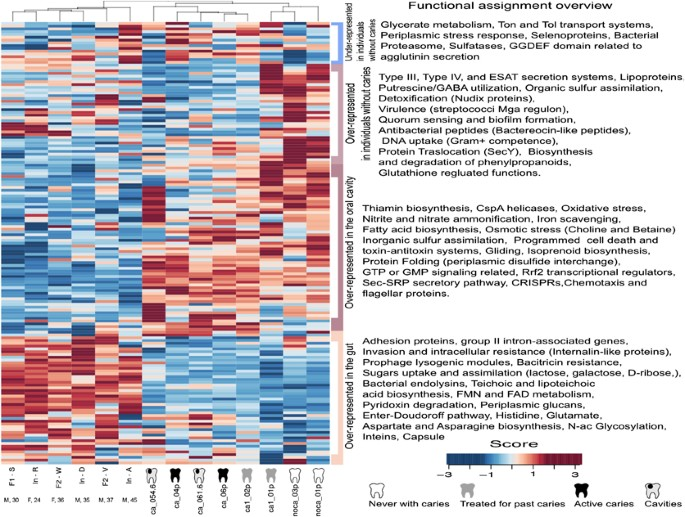|
Understanding the oral microbiome through OMICS analyses
The study of microorganisms has undergone an exciting revolution through the use of culture-independent techniques such as second and third generation sequencing technologies or high-throughput metagenomic cloning. The Oral Microbiology Lab has been a pioneer in the use of high-throughput analysis of DNA, RNA and proteins of oral samples, publishing the first metagenome, metatranscriptome and metaproteome of supragingival dental plaque. This has been possible thanks to the excellent work of the Sequencing Platform at FISABIO facilities and our experience in bioinformatic analysis, with the development of customized scripts and analysis pipelines. "Omics" approaches provide a powerful tool to understand microbial communities, as they allow not only the taxonomic characterization but also understanding their functional potential. For example, the metagenome of cavities allowed us to identify the ability of dentin microorganisms to degrade collagen and to extract carbohydrates from the human tissues without the need of dietary sugars, which led us to propose a tissue-dependent hypothesis of dental caries in 2012. By analyzing the metagenome of caries-free individuals, we could identify a set of functions associated with health, like bacteriocin production or the pathways to transform nitrate into ammonia or nitric oxide. We have recently completed the first metatranscriptome of tongue samples in patients with and without halitosis, identifying the metabolic pathways responsible for the production of sulfur volatile compounds involved in bad breath, and providing therapeutic options. In another metatranscriptomic study, we analyzed the effect of fluoride on microbial communities, identifying that this vital active ingredient of dentifrices shuts down bacterial sugar metabolism, reducing plaque acidogenicity. Finally, our metaproteomic analysis of dental plaque provided a series of biomarkers of dental caries that could serve to identify individuals at high caries risk. In addition to omics approaches, we routinely perform analysis of the 16S rRNA gene to describe bacterial and fungal composition in many oral samples, ranging from cavities, tongue, subgingival plaque, interproximal sites or saliva, among other niches.
Metagenome of gut (left) and oral (right) samples, showing the functional profile of microbial communities. Over-represented functions are shown in red, and under-represented functions in blue colours.
Participants: Dr. Miguel Carda
Selected publications:
- Simón-Soro A, Mira A. Solving the etiology of dental caries. Trends Microbiol. 2015 Feb; 23(2):76-82
- Simón-Soro A, Belda-Ferre P, Cabrera-Rubio R, Alcaraz LD, Mira A. A tissue-dependent hypothesis of dental caries. Caries Res. 2013;47(6):591-600.
- Belda-Ferre P, Alcaraz LD, Cabrera-Rubio R, Romero H, Simón-Soro A, Pignatelli M, Mira A. The oral metagenome in health and disease. ISME J. 2012 Jan;6(1):46-56.
- López-López A, Mira A. Shifts in Composition and Activity of Oral Biofilms After Fluoride Exposure. Microb Ecol. 2020 Oct;80(3):729-738.








